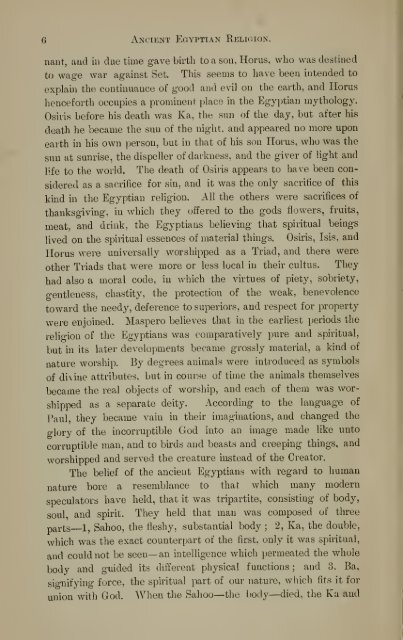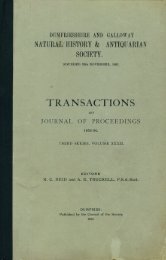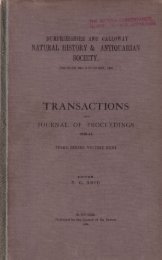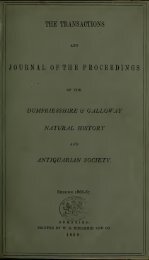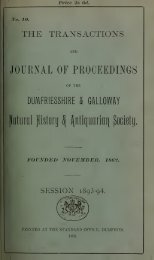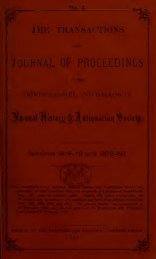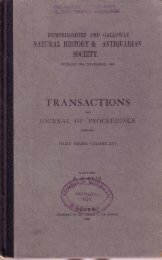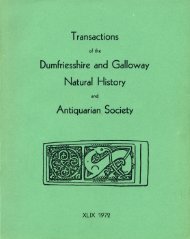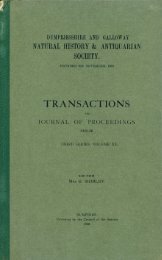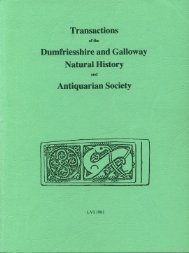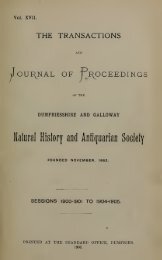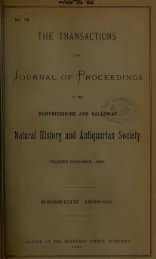Vol 13 - Dumfriesshire & Galloway Natural History and Antiquarian ...
Vol 13 - Dumfriesshire & Galloway Natural History and Antiquarian ...
Vol 13 - Dumfriesshire & Galloway Natural History and Antiquarian ...
You also want an ePaper? Increase the reach of your titles
YUMPU automatically turns print PDFs into web optimized ePapers that Google loves.
6<br />
Ancient Egyptian Religion.<br />
nant, aud in clue time gave birth to a son, Horus, who was destined<br />
to wage war against Set. This seems to have been intended to<br />
explain the continuance of good <strong>and</strong> evil on the earth, <strong>and</strong> Horus<br />
henceforth occupies a prominent place in the Egyptian mythology.<br />
Osiris before his death was Ka, the sun of the day, but after his<br />
death he became the sun of the night, <strong>and</strong> appeared no more upon<br />
earth in his own person, but in that of his son Horus, who was the<br />
sun at sunrise, the dispeller of darkness, aud the giver of light <strong>and</strong><br />
life to the world. The death of Osiris appears to have been con-<br />
sidered as a sacrifice for sin, <strong>and</strong> it was the only sacrifice of this<br />
kind in the Egyptian religion. All the others were sacrifices of<br />
thanksgiving, in which they offered to the gods flowers, fruits,<br />
meat, <strong>and</strong> drink, the Egyptians believing that spiritual beings<br />
lived on the spiritual essences of material things. Osiris, Isis, <strong>and</strong><br />
Horus were universally worshipped as a Triad, <strong>and</strong> there were<br />
other Triads that were more or less local in their cultus. They<br />
had also a moral code, in which the virtues of piety, sobriety,<br />
gentleness, chastity, the protection of the weak, benevolence<br />
toward the needy, deference to superiors, <strong>and</strong> respect for property<br />
were enjoined. Maspero believes that in the earliest periods the<br />
relio-ion of the Egyptians was comparatively pure <strong>and</strong> spiritual,<br />
but in its later developments became grossly material, a kind of<br />
nature worship. By degrees animals were introduced as symbols<br />
of divine attributes, but in course of time the animals themselves<br />
became the real objects of worship, <strong>and</strong> each of them was wor-<br />
shipped as a separate deity. According to the language of<br />
Paul, they became vain in their imaginations, <strong>and</strong> changed the<br />
glory of the incorruptible God into an image made like unto<br />
corruptible man, <strong>and</strong> to birds <strong>and</strong> beasts <strong>and</strong> creeping things, <strong>and</strong><br />
worshipped <strong>and</strong> served the creature instead of the Creator.<br />
The belief of the ancient Egyptians with regard to human<br />
nature bore a resemblance to that which many modern<br />
speculators have held, that it was tripartite, consisting of body,<br />
soul <strong>and</strong> spirit. They held that man was composed of three<br />
parts— 1, Sahoo, the fleshy, substantial body ; 2, Ka, the double,<br />
which was the exact counterpart of the first, only it was spiritual,<br />
<strong>and</strong> could not be seen— an intelligence which permeated the whole<br />
body <strong>and</strong> guided its different physical functions; <strong>and</strong> 3, Ba,<br />
sio-nifying force, the spiritual part of our nature, which fits it for<br />
union with God. When the Sahoo— the body—died, the Ka <strong>and</strong>


